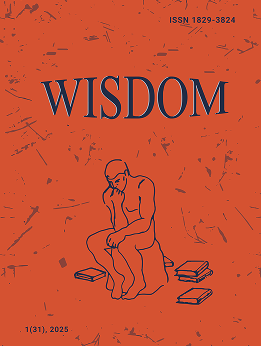Islamic Extremism Strategy of “Near and Far Enemy” (From the 1980s Till Now)
DOI:
https://doi.org/10.24231/wisdom.v21i1.702Keywords:
Islamic Extremism, “Near and Far Enemy”, Abdullah Azzam, Usama bin Ladin, “Al-Qaeda”, ISISAbstract
In the 1980s, the “Al-Qaeda” launched the tactics of the struggle against the “Near and Far Enemy”. It found its ideological grounds in the Islamic extremism in the 1980-90s with practical implications, affecting the current geopolitical and global economic trends in the Muslim world and well beyond it. In the Islamic extremism ideology, this strategy also received textual-substantive justifications of symbolic perceptions, which, of course, influenced the behaviour of extremists. The present research attempts to investigate the peculiarities of the tactics mentioned, which were masterminded and enriched by the ideologists of Islamic extremism, becoming one of the motives of the activities of Islamic extremists starting from the 1980s up to the current developments and one of the grounds for targets of Jihad.
Downloads
References
Al Qaedaís Second Fatwa, (1998, February). World Islamic Front Statement. Retrieved from https://irp.fas.org/world/para/docs/980223-fatwa.htm
Al-Shishani, B. M. (2011, June). Understanding strategic change in Al-Qaedaís central leadership after Bin Ladin. Terrorism Monitor, the Jamestown Foundation, IX(23), 7-8.
Al-Suri, A. M. (2004, December). Dawa Muqauama alislamia alalamia (The global Islamic resistance call, in Arabic). Retrieved from https://archive.org/details/Dawaaah/mode/2up?view=theater
Al-Tamimi, A. J. (2014, October). The Islamic Stateís regional strategy, European Council on Foreign Relations. Retrieved from http://www.ecfr.eu/article/comment-ary_the_islamic_states_regional_strategy326
Aydin, S., Cicek, C., Artunay, C., & Certel, A. B. (2016, May). Essay on the phenomenon of violence and alienation originate in the context of the symbolism and signification process. International Journal of Social Science and Humanity, 6(5), 402-407.
Bonney, R. (2007). Jihad from Quran to bin Ladin. New York: Palgrave Macmillan.
Caillet, R. (2013, December). The Islamic State, Leaving Al-Qaeda behind. Carnegie Middle East Center. Retrieved from http://carnegie-mec.org/diwan/54017?lang=en
Declaration of war against the Americans occupying the land of the two holy places by Usama bin Ladin, Combating Terrorism Center. Retrieved from https://ctc.usma.edu/wp-content/uploads/2013/10/Declaration-of-Jihad-against-the-Americans-Occupying-the-Land-of-the-Two-Holiest-Sites-Translation.pdf
Gohel, M. S. (2017, February). Deciphering Ayman al-Zawahiri and Al-Qaedaís strategic and ideological imperatives. Terrorism Research Institute, Perspectives on Terrorism, 11(1), 54-67.
Harutyunyan, M. A. (2010, April-June,). Otarvats hajy ankakh Hayastanum (The alternated Armenian in independent Armenia, in Armenian). Vem Pan-Armenian Journal, 2(30), 70-84.
Kepel, G. (2006). The trail of political Islam. London: I.B. Tauris.
Kohlman, F. E. (2004). Al-Qaidaís Jihad in Europe: The Afghan-Bosnian network. Oxford, New York: Berg.
Marranci, G. (2006). Jihad beyond Islam. Oxford: Oxford International Publishers Ltd.
Stern, J., & Berger, M. (2015). ISIS: The state of terror (1st ed.). New York: Ecco/Harper Collins Publishers.
The 9/11 Commission Report (2004). Retrieved from https://www.9-11commission.gov/report/911Report.pdf.
The Encyclopaedia of Islam (1991). (Vol. 2). Leiden, Netherlands: E. J. Brill.
Withnall, A. (2014, June). Iraq crisis: Isis declares its territories a new Islamic state with ërestoration of caliphateí in Middle East. The Independent. Retrieved from https://www.independent.co.uk/news/world/middle-east/isis-declares-new-islamic-state-in-middle-east-with-abu-bakr-albaghdadi-as-emir-removing-iraq-and-syria-from-its-name-9571374.html.
Zawahiriís Letter to Zarqawi (2005, July). Combating Terrorism Center at West Point. Retrieved from https://ctc.usma.edu/harmony-program/zawahiris-letter-to-zarqawi-original-language-2/
Downloads
Published
How to Cite
Issue
Section
License
Copyright (c) 2022 scientific journal WISDOM

This work is licensed under a Creative Commons Attribution-NoDerivatives 4.0 International License.
Creative Commons Attribution-Non-Commercial (CC BY-NC). CC BY-NC allows users to copy and distribute the article, provided this is not done for commercial purposes. The users may adapt – remix, transform, and build upon the material giving appropriate credit, and providing a link to the license. The full details of the license are available at https://creativecommons.org/licenses/by-nc/4.0/.















